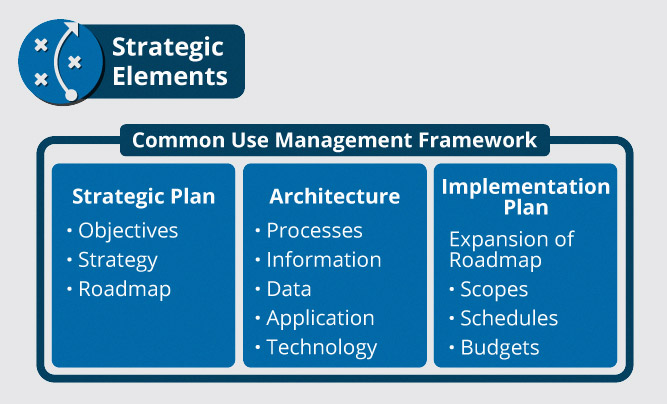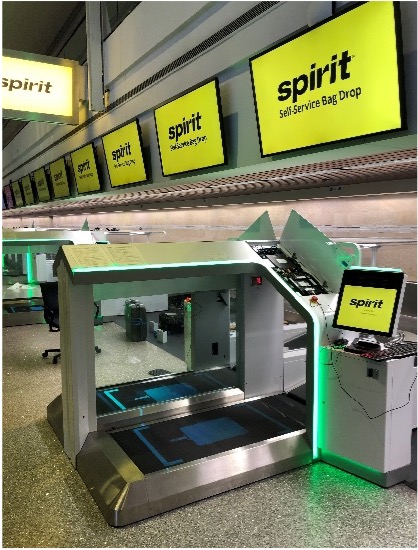


This page includes all content for this chapter.
Chapter 6: Establish Strategic Elements
With a governance framework in place, you are ready to develop the specific strategic elements required to define the common use program's management framework, including a strategic plan, architecture, and implementation plan, as shown in Figure 6.1.

Figure 6.1: Strategic Elements of a Holistic Common Use Program
The strategic elements start with the development of a management framework that defines the overall structure needed to achieve the governance objectives of ensuring benefits delivery, risk optimization, resource optimization, and stakeholder transparency. Within the management framework, the common use objectives define what you want to accomplish, the strategy defines how you are going to accomplish it, and the roadmap identifies the milestones along the journey. Then, the architecture defines how you are aligning within the existing environment, and the implementation plan defines the needed details for the initiatives along the roadmap.
This will require significant collaboration across the airport business units, as well as with external stakeholders, such as the airlines, CBP, TSA, concessionaires, and business partners. During this process, it is important to plan and develop these elements at a level that is consistent with your airport's current common use maturity level and the roles and responsibilities based on your unique starting point.
Common Use Management framework
A common use management framework is an essential component of the overall common use program and is the means through which the governance of the airport's common use vision and objectives are maintained. It is through this framework that the airport implements and maintains mechanisms and authorities to manage information and the use of common use in the airport in support of governance objectives and in line with guiding principles and policies. The management framework provides a consistent management approach to enabling the airport governance requirements to be met through management processes, organizational structures, roles and responsibilities, reliable and repeatable activities, and skills and competencies. See Chapter 9 for more details on the management responsibilities.
Consider the following questions as you develop a common use management framework:
- Does your framework have an organizational structure that reflects business needs and common use priorities with management committees in place to enable management decision-making in an effective and efficient manner?
- Have you established and communicated roles and responsibilities for common use staff and stakeholders that reflect the overall business needs and common use objectives?
- Do you communicate awareness and understanding of common use objectives and direction to appropriate stakeholders and users throughout the airport?
- Is the common use program reflected appropriately in the overall airport's organizational structure to properly align with the airport strategy and the level of operational dependence on common use?
- Are the responsibilities for ownership of common use-related data and information systems adequately defined and maintained?
- Is the continual improvement of processes and their maturity assessed to ensure that they can deliver against airport, governance, and management objectives?
- Are procedures in place to maintain compliance with and performance measurement of policies and procedures and address non-compliance or inadequate performance?
Establish Your Common Use Strategic Plan
To establish the path forward for the common use program, you need to establish a holistic view of the current business and common use environment, the future direction, and the initiatives required to migrate to the desired future environment. You should leverage the existing airport organizational components, including externally provided services and related capabilities to achieve strategic objectives and develop a common use strategic plan in alignment with airport business objectives.
In the common use strategic plan, you need to clearly communicate the specific common use objectives, shown in alignment with the airport objectives, so they are understood by all, with the common use strategic options identified, structured, and integrated with the business plans into the common use roadmap.
Consider the following questions as you develop a common use strategy:
- Does your strategy consider the current airport architecture, including the organizational structure, systems and processes, skills and capabilities, and culture, as well as the airport strategy and future objectives?
- Does your strategy consider the external environment of the airport, including industry drivers, relevant regulations, passenger needs, and basis for airline competition?
- Have you assessed the performance of current internal business and common use capabilities and external common use services and developed an understanding of the airport architecture in relation to common use?
- Have you identified issues currently being experienced and developed recommendations in areas that could benefit from improvement?
- Have you assessed service provider differentiators and options and the financial impact and potential costs and benefits?
- Have you defined the target business and common use capabilities and required common use services based on the understanding of the airport environment and requirements; the assessment of the current business process and common use environment and issues; and consideration of standards, best practices, and validated emerging technologies or innovation opportunities?
- Have you identified the gaps between the current and target environments and considered the alignment of resources with business outcomes?
- Have you defined the critical success factors to support strategy execution?
- Have you created a strategic plan with a high-level roadmap that defines, in cooperation with relevant stakeholders, how common use-related objectives will contribute to the airport's strategic goals?
- How will the common use program support common use-enabled initiatives, business processes, common use services, and common use assets?
- What are the initiatives that will be required to close the gaps?
- What is the sourcing strategy?
- What are the measurements to be used to monitor the achievement of objectives?
- How are the initiatives prioritized in the common use roadmap?
- Have you created awareness and understanding of the business and common use objectives and direction, as captured in the common use strategy, through communication to appropriate stakeholders and users throughout the airport?
Develop Your Common Use architecture and implementation plan
After developing the objectives, strategy, and roadmap, you need to develop a common use architecture that includes business process, information, data, application, and technology architecture layers for achieving airport and common use strategies. You should define requirements for standards, guidelines, procedures, and tools that will help improve alignment, increase agility, improve quality of information, and generate potential cost savings. Consider the different components that make up the airport and their inter-relationships as well as the principles guiding their design and evolution over time to enable the accomplishment of operational and strategic objectives.
You will then be prepared to expand the common use roadmap into an implementation plan that goes beyond the phasing of strategic initiatives into the definition of the scopes, means, and methods required for implementation. Consider the following questions as you develop a common use architecture and implementation plan:
- What are the gaps between baseline and target architectures from both business and technical perspectives?
- What are the logical groupings that will make up project work packages?
- How do these work packages integrate with related programs to ensure that the initiatives are aligned with overall airport organizational change?
- What key airport stakeholders from business, operations, and IT need to collaborate to assess the airport's transformation readiness?
- What are the opportunities, solutions, and implementation constraints?
- What is the practical implementation and migration plan?
- How do the initiatives in the implementation plan align with current program and project portfolios?
- How is the plan coordinated to make sure that value is delivered, and the required resources are available to complete the necessary work?
When considering the strategic elements described in this chapter, it may seem like an overwhelming and impractical amount of effort to take on in addition to the workload that you are already managing. The French writer Voltaire is quoted as saying, “Perfect is the enemy of good,” and in this case that is true. In developing this holistic common use program, you are not striving for perfection, but rather progress. Within each of these strategic elements, identify those things that are obvious priorities, and start making progress. Then you will be ready to jump into implementation, as outlined in Part 4.



